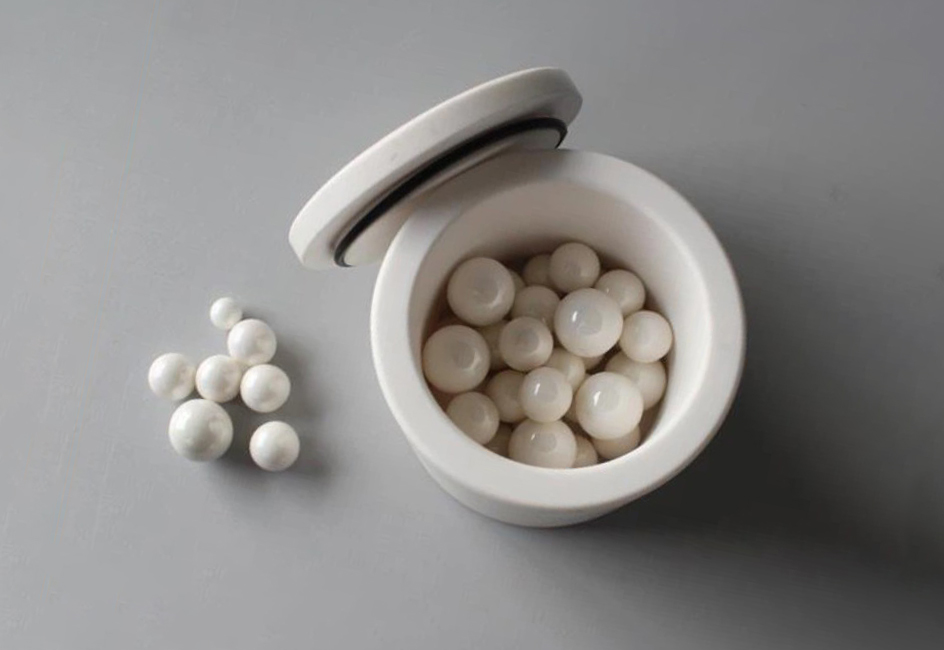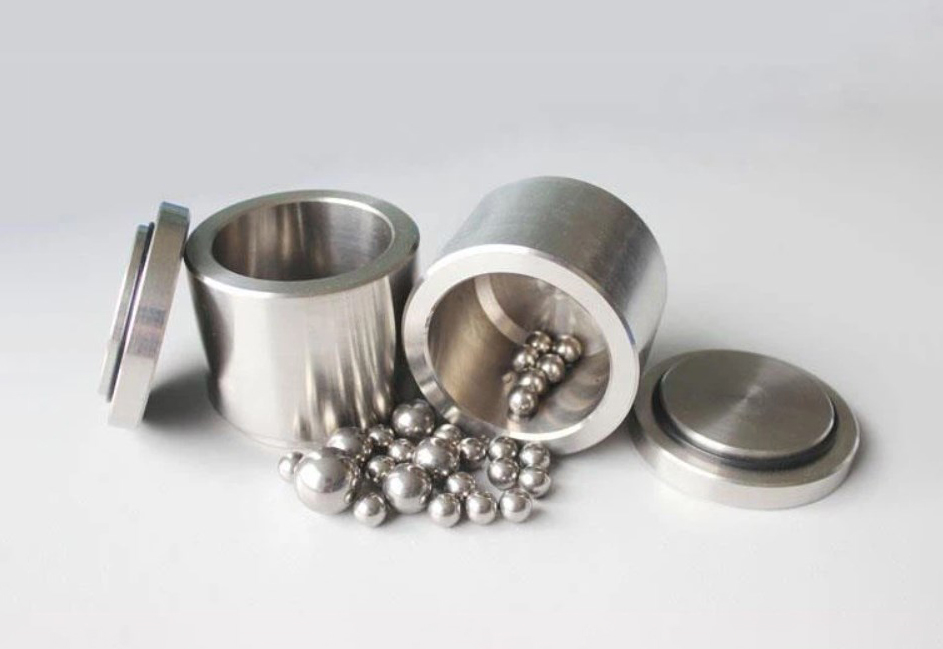Material Matters: How to Choose the Right Grinding Balls and Jars?

Introduction
Grinding is a crucial step in various industrial and research processes, shaping the efficiency and outcome of material preparation. The choice of grinding balls and jars, integral to this process, significantly affects the quality of the final product, the efficiency of the operation, and the cost-effectiveness of the materials' processing.
This article aims to guide you through selecting the right materials for these components, ensuring optimal results across a wide range of applications. By making informed decisions, you can enhance both the performance of your grinding processes and the quality of your outcomes.
Overview of Grinding Process
Grinding is a fundamental mechanical process aimed at reducing solid materials to a desired particle size or achieving a homogeneous mixture. This process, crucial in both industrial applications and research, involves the use of balls and jars to exert physical forces that fragment the material into smaller pieces or powders. Grinding serves essential purposes such as size reduction, which increases material surface area for enhanced chemical reactions and improved mixing qualities, and homogenization for uniform mixtures, critical in quality control across various fields like pharmaceuticals and food.
The choice of material for grinding balls and jars significantly influences the process's efficiency, the purity of the final product, and the durability of the grinding media. Selecting compatible materials for the balls and jars relative to the substance being ground is critical. The right selection prevents sample contamination, ensures operational efficiency, and extends the lifespan of grinding components, thus impacting the overall effectiveness and cost-effectiveness of the grinding operation.
Factors to Consider When Choosing Materials
Selecting the right materials for grinding balls and jars is critical for ensuring optimal outcomes in grinding processes. Three primary factors to consider are sample compatibility, grinding efficiency, and the balance between durability and cost.
Sample Compatibility
The material of the grinding balls and jars can significantly impact the purity of the sample. Certain materials can contaminate the sample by shedding particles or reacting chemically with the sample during the grinding process. For instance, steel balls might introduce iron contamination in samples sensitive to magnetic materials, affecting subsequent analyses or applications. Therefore, it's essential to choose materials that are inert or have minimal reactivity with the sample being ground, such as zirconia or tungsten carbide for chemically aggressive samples.
Grinding Efficiency
The density of the materials used for grinding balls and jars also plays a crucial role in grinding efficiency and energy transfer. Heavier and denser materials, like tungsten carbide, can exert more force on the sample with each impact, leading to faster and more effective size reduction. However, the choice must also consider the type of material being ground to avoid excessive wear or damage to the sample. Optimizing grinding efficiency requires a balance between the physical properties of the grinding media and the nature of the sample.
Durability and Cost
The durability of grinding materials directly influences their cost-effectiveness. More durable materials, such as tungsten carbide or zirconia, might have a higher upfront cost but offer longer service life, reducing the frequency of replacement and, consequently, the long-term operational costs. Conversely, less durable materials like agate or stainless steel may incur lower initial expenses but require more frequent replacements, potentially increasing costs over time. When evaluating materials, consider both their wear resistance and impact on overall operating expenses, aiming for a balance that meets both budgetary constraints and operational needs.
Types of Materials Used for Balls and Jars
Materials Used for Grinding Balls
Grinding balls are the media placed inside the grinding jars along with the material to be ground. Their primary function is to impact the material to reduce its size.
The choice of material for grinding jars depends on the specific requirements of the grinding process, including the physical and chemical compatibility with the sample material, the hardness of the materials to be ground, and the desired degree of contamination control. Common materials include:
- Zirconium Oxide: Ideal for high-energy mills, offering high wear resistance and minimal contamination.
- Alumina: Used for grinding applications requiring no metallic contamination.
- Silicon Nitride: Known for its high strength, hardness, and thermal resistance, suitable for high-temperature applications.
- Stainless Steel: Good for general-purpose grinding, especially for metallic samples.
- Tungsten Carbide: Offers high density and extreme hardness, making it suitable for grinding tough materials.
- Agate: Preferred for minimal contamination and for grinding soft to medium-hard materials.
Further Reading: What Are the Ceramic Materials Used as Grinding Media?
Here's a comparison table based on the materials used to make grinding balls, considering factors such as sample compatibility, grinding efficiency, durability, and cost. This table can help guide the selection of the most appropriate material for specific applications:
|
Material |
Sample Compatibility |
Grinding Efficiency |
Durability |
Cost |
|
Zirconium Oxide |
High (Low Contamination) |
High |
High |
High |
|
Alumina |
High (Low Contamination) |
High |
High |
Moderate |
|
Silicon Nitride |
High (Low Contamination) |
High |
Very High |
High |
|
Stainless Steel |
Moderate (Some Contamination) |
Moderate |
Moderate |
Low |
|
Tungsten Carbide |
High (Low Contamination) |
Very High |
Very High |
High |
|
Agate |
High (Low Contamination) |
Low |
Low |
Low |
This table highlights the trade-offs between different materials in terms of their compatibility with samples (risk of contamination), efficiency in grinding (how effectively and quickly they can reduce material size), durability (how resistant they are to wear and tear), and overall cost (both initial and long-term).
For instance, while Zirconium Oxide, Silicon Nitride, and Tungsten Carbide offer high efficiency and low contamination risks, they come at a higher cost. On the other hand, materials like Stainless Steel and Agate provide more cost-effective solutions but may not offer the same level of performance or compatibility for sensitive samples.

Materials Used for Grinding Jars
Grinding jars, also known as milling jars or process jars, are containers that are filled with one or more grinding media (balls) and the material to be ground. They are then placed in a ball mill that subjects them to a high-energy mechanical impact process. This process involves rotational or vibratory motion to induce collisions between the grinding media and the material, resulting in particle size reduction.
Similar to balls, grinding jars are made from various materials, each suitable for specific types of samples and grinding needs:
- Zircona: Highly resistant to wear and corrosion, it’s suitable for grinding highly abrasive samples. Zirconia jars are also used when no contamination is permitted.
- Aluminum Oxide: Good for grinding applications where purity is important. It's resistant to wear and corrosion and often used for pharmaceuticals and food-grade samples.
- Polyethylene: Used for cryogenic grinding or when samples need to be prepared at low temperatures.
- PTFE (Teflon): Known for its chemical inertness, making it suitable for grinding aggressive materials without risking contamination.
- Stainless Steel: Offers durability and resistance to wear and corrosion. Ideal for grinding semi-hard to hard samples.
- Tungsten Carbide: Extremely hard and durable, suitable for grinding hard, abrasive samples. It has very high wear resistance.
- Agate: A naturally occurring form of silica, known for its hardness and resistance to abrasion. It’s less contaminating than other materials, making it suitable for applications where minimal contamination is crucial.
Here's a comparison table for materials used to make grinding jars, considering factors such as sample compatibility, grinding efficiency, durability, and cost:
|
Material |
Sample Compatibility |
Grinding Efficiency |
Durability |
Cost |
|
Zirconium Oxide |
High (Low Contamination) |
High |
High |
High |
|
Alumina |
High (Low Contamination) |
High |
High |
Moderate |
|
Polyethylene |
Moderate (Some Contamination) |
Low |
Low |
Low |
|
PTFE |
High (Low Contamination) |
Low |
Low |
Moderate |
|
Stainless Steel |
Moderate (Some Contamination) |
Moderate |
High |
Low |
|
Agate |
High (Low Contamination) |
Low |
Low |
Low |
This table aims to assist in selecting the most suitable material for grinding jars, based on the required sample compatibility, desired grinding efficiency, durability expectations, and budget considerations.
Materials like Zirconium Oxide and Alumina offer high performance in terms of compatibility and efficiency but come at a higher or moderate cost. Polyethylene and PTFE, while offering certain advantages such as low cost for Polyethylene and high sample compatibility for PTFE, may not provide the same level of grinding efficiency or durability. Stainless Steel and Agate present cost-effective options with moderate to low grinding efficiency, suitable for applications where sample contamination is less of a concern.
Application-Specific Recommendations
When choosing materials for grinding balls and jars, it's crucial to consider the specific requirements of the application at hand. Different industries and types of analysis demand materials with particular properties to ensure the integrity of the sample and the efficiency of the process. Here are some guidelines and examples for selecting materials based on application needs:
Pharmaceuticals
In the pharmaceutical industry, the purity of the sample is paramount. Contamination can compromise the integrity of research results and affect the safety and efficacy of drug formulations. Recommended Materials: Non-contaminating, inert materials like Zirconium Oxide and Agate are ideal for pharmaceutical applications. These materials minimize the risk of altering the chemical composition of the sample.
Case Study: In a study involving the formulation of a new drug, researchers switched from stainless steel to agate grinding balls and jars. This change significantly reduced contamination, ensuring that the final product met stringent purity standards and passed regulatory approval more swiftly.
Materials Science and Engineering
Research and development in materials science often involve the study of novel composites and alloys, where the mechanical properties and purity of samples are crucial. Recommended Materials: Tungsten Carbide and Silicon Nitride offer high grinding efficiency and durability, suitable for hard, abrasive materials.
Example: In the development of a new high-strength alloy, the use of tungsten carbide grinding balls enabled more efficient size reduction without adding impurities, leading to accurate characterization of the alloy's properties.
Environmental Testing
Testing environmental samples, such as soils and sediments, requires careful consideration to avoid contamination that could skew the analysis of pollutants or minerals. Recommended Materials: Polyethylene and PTFE jars, known for their chemical inertness, are suitable for grinding environmental samples, particularly when testing for organic contaminants.
Case Study: An environmental lab found that switching to PTFE grinding jars helped in accurately quantifying trace levels of pesticides in soil samples, as it eliminated the trace metal contamination observed with previous materials.
Food and Agriculture
Food safety testing and agricultural research often involve the analysis of organic compounds and trace elements in food products and crops. Recommended Materials: Stainless Steel and Alumina are typically used for general purposes, but Zirconium Oxide is preferred for applications requiring higher purity and minimal contamination risk.
Example: A study on nutrient content in certain grains utilized zirconium oxide grinding balls to prevent cross-contamination with gluten from previous samples, ensuring accurate gluten-free certification.
Here's a table summarizing application-specific recommendations for selecting materials for grinding balls and jars, along with reasons for these recommendations and relevant examples or case studies:
|
Application |
Recommended Materials |
Reason |
Example/Case Study |
|
Pharmaceuticals |
Zirconium Oxide, Agate |
Minimize contamination, ensure purity |
Switching to agate reduced drug formulation contamination |
|
Materials Science and Engineering |
Tungsten Carbide, Silicon Nitride |
High grinding efficiency for hard materials |
Tungsten carbide enabled efficient alloy characterization |
|
Environmental Testing |
Polyethylene, PTFE |
Chemical inertness for organic contaminants |
PTFE jars for accurate pesticides quantification in soil |
|
Food and Agriculture |
Zirconium Oxide |
Prevent cross-contamination, ensure purity |
Zirconium oxide for accurate gluten-free certification |
Conclusion
In this article, we've underscored the crucial role of selecting the right materials for grinding balls and jars in achieving optimal grinding efficiency and ensuring sample integrity. Factors such as sample compatibility, grinding efficiency, and the durability-cost balance were examined alongside material recommendations for specific applications.
Selecting the appropriate materials, from Zirconium Oxide and Alumina to Silicon Nitride and Tungsten Carbide, significantly affects the grinding process's outcome. Whether for pharmaceuticals, materials science, environmental testing, or food and agriculture, each application demands careful consideration of material properties to avoid contamination and enhance performance.
Advanced Ceramic Materials (ACM), a leading ceramic supplier, plays a pivotal role in providing high-quality materials that meet the diverse needs of these applications. By leveraging the insights provided and partnering with suppliers like ACM, industry professionals can ensure their grinding operations are not only effective but also cost-efficient and aligned with their specific requirements.
{{item.content}}
LEVE A REPLY
{{item.children[0].content}}
{{item.content}}
LEAVE A REPLY
SUBSCRIBE OUR NEWSLETTER
- Boron Nitride in Cosmetics: Enhancing Performance and Sensory Appeal
- Maximize MOCVD Yield and Purity with Hexagonal Boron Nitride Setters
- What Are the Advantages and Uses of Boron Nitride Ceramic Sheet?
- The Compression Annealing Advantage for Pyrolytic Boron Nitride
- Beyond Insulation: The Surprising Spectrum of Ceramic Thermal Conductivity











